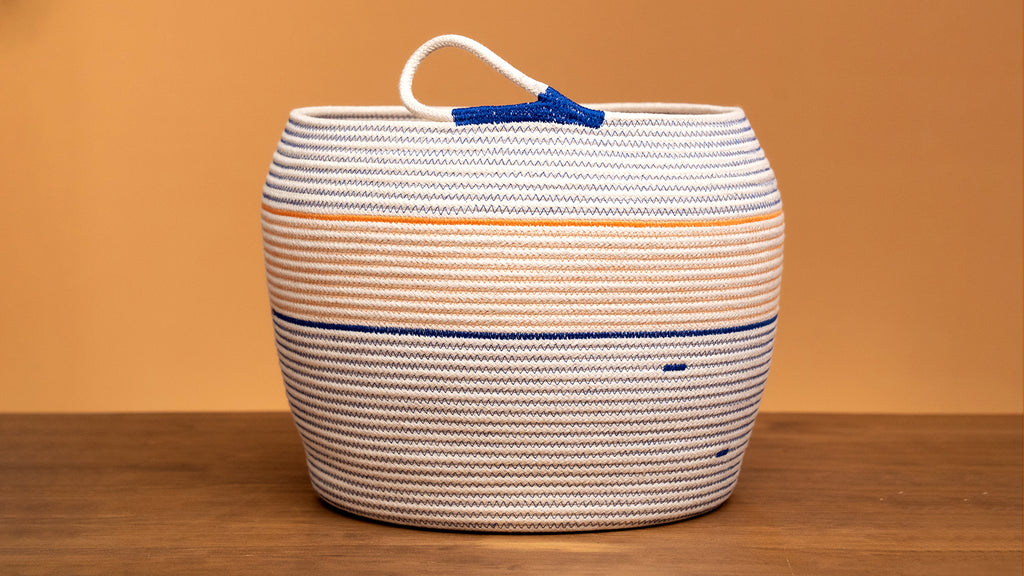Ropework as Sustainable Decor: Eco-Friendly Home Design Trends

Ropework as Sustainable Decor: Eco-Friendly Home Design Trends
By Jessica Geach
In the ever-evolving world of interior design, sustainability has become a dominant theme. As we seek ways to reduce our environmental footprint and live more harmoniously with nature, eco-friendly design trends are gaining momentum. One such trend that has captured the imagination of many is the use of ropework and natural fibers in homeware. In this article, we'll delve into how ropework aligns with eco-friendly design principles and why it's a sustainable decor choice for your home.
The Resurgence of Ropework in Home Decor
Ropework, which includes stitching, knotting, weaving, and other techniques using ropes and natural fibers, has a rich history that dates back centuries. Traditionally, it was used for practical purposes, like ship rigging and fishing nets. Over time, however, it has evolved into an art form and a means of creating stunning, handcrafted homeware items.
The resurgence of ropework in home decor can be attributed to various factors, one of which is its inherent sustainability. Today, we're seeing an increasing number of homeowners and designers turning to ropes made from natural fibers like cotton, hemp, and jute. These materials are biodegradable and renewable, making them an eco-conscious choice.
Sustainability at Its Core
One of the primary reasons ropework aligns so well with eco-friendly design is its minimal environmental impact. Let's explore some key aspects that highlight the sustainability of ropework in home decor:
- Biodegradability
Natural fibers used in ropework, such as cotton and hemp, are biodegradable, meaning they break down naturally over time, leaving no harmful residues in the environment. This contrasts sharply with synthetic materials like plastic, which can take centuries to decompose.
- Renewable Resources
Cotton, hemp, and jute are all renewable resources. These plants can be grown without the use of harmful pesticides and synthetic fertilizers, reducing the overall ecological footprint.
- Low Energy Production
Ropework typically requires minimal energy for production compared to many other manufacturing processes. This reduces greenhouse gas emissions and energy consumption.
- Artisan Craftsmanship
Handcrafted ropework homeware often involves local artisans who use their skills to create unique pieces. Supporting artisanal production encourages sustainable livelihoods and helps preserve traditional craftsmanship.
- Longevity
Many ropework homeware items are built to last. Their durability means they won't end up in landfills as quickly as mass-produced, disposable decor items.
Ropework's Versatility in Eco-Friendly Design
One of the remarkable features of ropework is its adaptability to various design styles, making it a versatile choice for eco-friendly home decor. Whether you're a fan of minimalist Scandinavian interiors, bohemian chic, or rustic farmhouse aesthetics, there's a ropework piece to suit your style. Here are some ways you can incorporate ropework into your sustainable design vision:
- Wall Hangings
Ropework wall hangings add texture and character to your walls. They can serve as statement pieces or subtle accents, depending on your preferences.
- Plant Hangers
Elevate your indoor plant game with natural fiber plant hangers. They're not only functional but also aesthetically pleasing.
- Table Centerpieces
Ropework can be used to create stunning table centerpieces, from intricate table runners to unique placemats.
- Lighting Fixtures
Ropework pendant lights or chandeliers can create a warm and inviting ambiance in any room.
- Furniture Accents
Incorporate ropework into furniture designs, such as chair backs or headboards, to add a touch of eco-friendliness to your decor.
In a world increasingly focused on sustainable living, the selection of decor materials carries significant importance. Ropework, distinguished by its utilization of natural fibers and artisanal craftsmanship, seamlessly aligns with prevailing eco-friendly design trends. It embodies fundamental principles like biodegradability, renewability, and a minimal environmental footprint.
To aid you in your sustainable decor journey, I've assembled a complimentary resource containing all the necessary materials you will need to get you started. And if you seek guidance and expertise along the way, consider exploring my course, Artisan Ropework Homeware.
By making ropework a central element in your home decor, you not only contribute to a more sustainable planet but also imbue your living spaces with the elegance of handcrafted, environmentally conscious design. Embrace the allure and sustainability of ropework within your home, and witness your living environment evolve into a sanctuary that seamlessly combines style with environmental responsibility.

Leave a comment